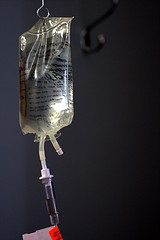How much is that saline drip in the hospital? The NY Times has some shocking news.
The saline drip; it seems like everybody in the hospital has an IV line in their arm. Saline or salt water is cheaper than a can of coca cola. Each bag of saline should cost under $1, however, after the wholesalers, distributors and hospitals get done with it, it costs an arm and a leg.
When we look at what is wrong with medical care in the US, and why it costs more than anywhere else for care that is often no better or special than other areas in the world that cost less than half, perhaps this is just on example of why, with middlemen laughing all the way to the bank.
What is wrong with this picture?
Check out the NY Times article here
How to Charge $546 for Six Liters of Saltwater
By NINA BERNSTEIN
Published: August 25, 2013
It is one of the most common components of emergency medicine: an intravenous bag of sterile saltwater.
Luckily for anyone who has ever needed an IV bag to replenish lost fluids or to receive medication, it is also one of the least expensive. The average manufacturer’s price, according to government data, has fluctuated in recent years from 44 cents to $1.
Yet there is nothing either cheap or simple about its ultimate cost, as I learned when I tried to trace the commercial path of IV bags from the factory to the veins of more than 100 patients struck by a May 2012 outbreak of food poisoning in upstate New York.
Some of the patients’ bills would later include markups of 100 to 200 times the manufacturer’s price, not counting separate charges for “IV administration.” And on other bills, a bundled charge for “IV therapy” was almost 1,000 times the official cost of the solution.
It is no secret that medical care in the United States is overpriced. But as the tale of the humble IV bag shows all too clearly, it is secrecy that helps keep prices high: hidden in the underbrush of transactions among multiple buyers and sellers, and in the hieroglyphics of hospital bills.
At every step from manufacturer to patient, there are confidential deals among the major players, including drug companies, purchasing organizations and distributors, and insurers. These deals so obscure prices and profits that even participants cannot say what the simplest component of care actually costs, let alone what it should cost.
And that leaves taxpayers and patients alike with an inflated bottom line and little or no way to challenge it.
A Price in Flux
In the food-poisoning case, some of the stricken were affluent, and others barely made ends meet. Some had private insurance; some were covered by government programs like Medicare and Medicaid; and some were uninsured.
In the end, those factors strongly (and sometimes perversely) affected overall charges for treatment, including how much patients were expected to pay out of pocket. But at the beginning, there was the cost of an IV bag of normal saline, one of more than a billion units used in the United States each year.
Read more
